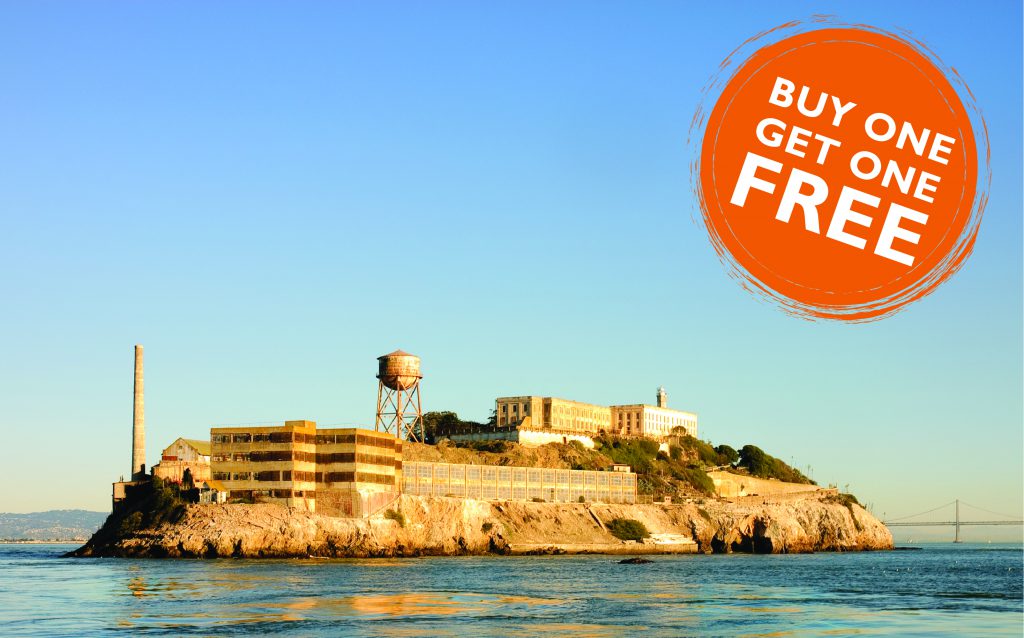Although Alcatraz Cruises’ tours often sell out during the year, it is a priority to educate the community about the robust history of the Island. As a result, Alcatraz Cruises wants to encourage local residents to experience the assets that make Alcatraz Island one of the country’s most visited national parks.
Histoire d'Alcatraz
"Malgré ce qu'ils vous disent, je pense qu'ils sont un peu nostalgiques. Je pense que cet endroit va leur manquer." - Fred T. Williamson, directeur d'Alcatraz, lorsque les derniers détenus ont été expédiés en 1963.
Few islands in the world can boast such a glorious natural setting – and grim human past – as Alcatraz. Visited by Native Americans as early as 10,000 years ago, the barren island remained uninhabited until Europeans arrived. Spanish and Mexican settlers in the early 1800s called the guano-covered island “Isla de los Alcatraces” – Island of Pelicans.
Peu après l'acquisition de l'île au Mexique en 1848, l'armée américaine a construit ce qui allait devenir le plus grand fort de défense à l'ouest du Mississippi pendant la guerre civile (1861-1865). Alcatraz est également devenue une balise pour les navires entrant dans les eaux dangereuses du Golden Gate après la mise en service de son phare, le premier de la côte ouest, en 1854,
Alcatraz began its long era as a dreaded place of confinement when soldier convicts were first imprisoned at the fort in 1860. Over the next decades, the island became less of a defense fort and more of a military prison, with Army convicts building most of the structures still standing on Alcatraz today.
Alcatraz was reborn as a civilian Federal Penitentiary in 1934, becoming known in the press as “The Rock” and “America’s Devil’s Island.” Wardens at Atlanta, Leavenworth, and other federal prisons selected their most unruly convicts to transfer there, among them Al Capone and “Machine Gun” Kelly. No less tough and carefully selected were the correctional officers, one for every three prisoners, who were trained to use their wits as well as their muscles when trouble broke out.
Alcatraz was the most escape-proof prison in the nation. Even if a convict could get past the remote-control locks, guard towers, and barbed wire, he had to struggle against swirling tides and icy waters to reach shore. Yet, escape was uppermost on the minds of many inmates. “Alcatraz is becoming a prison of madmen and men half mad,” Al “The Bug” Loomis, a bank robber once incarcerated there, wrote in 1938. “The sustaining hope is escape.”
Au fil des ans, des évadés ont fabriqué des ailes d'eau rudimentaires et des nageoires en bois et ont tenté de nager, mais ils se sont noyés ou ont été rattrapés pendant qu'ils nageaient. En 1962, le condamné John Paul Scott est devenu le premier et le seul évadé du pénitencier à atteindre le rivage de San Francisco. Il a été découvert inconscient sur les rochers de Fort Point, violet et tremblant, avec seulement ses chaussettes. Trop faible pour continuer, il s'est retrouvé au point de départ.
In that same year, Attorney General Robert F. Kennedy announced the phase-out of the prison. Alcatraz was turned over to the General Services Administration as surplus property and most of the inmates were transferred to a new facility in Marion, Ill. Over the next few years, hundreds of proposals were submitted for new uses for the island, including a West Coast version of the Statue of Liberty, a casino resort, and space museum.
In 1969, a group of 300 Native Americans began a 19-month occupation of Alcatraz, claiming rights to the island under an old Sioux Treaty that gave Native Americans the right to homestead unused federal lands. While the Occupation put a media spotlight on Native American issues, the numbers of activists gradually dwindled and Federal marshals removed the last few from the island in June 1971. Each November Native Americans of many tribes return to Alcatraz to hold a sunrise ceremony commemorating the Occupation.
En 1972, Alcatraz a été intégrée à la Golden Gate Recreation Area, une unité du National Park Service. Les visites d'Alcatraz ont commencé l'année suivante, attirant désormais quelque 1,7 million de visiteurs par an dans un lieu que tant d'hommes avaient rêvé de ne jamais revoir.


